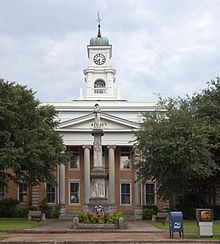Hale County, Alabama
| Hale County, Alabama | |
|---|---|

Hale County Courthouse in Greensboro
|
|
 Location in the U.S. state of Alabama |
|
 Alabama's location in the U.S. |
|
| Founded | January 30, 1867 |
| Named for | Stephen F. Hale |
| Seat | Greensboro |
| Largest city | Greensboro |
| Area | |
| • Total | 657 sq mi (1,702 km2) |
| • Land | 644 sq mi (1,668 km2) |
| • Water | 13 sq mi (34 km2), 1.9% |
| Population (est.) | |
| • (2015) | 15,068 |
| • Density | 24/sq mi (9/km²) |
| Congressional district | 7th |
| Time zone | Central: UTC-6/-5 |
|
Footnotes:
|
|
Footnotes:
Hale County is a county of the U.S. state of Alabama. As of the 2010 census, the population was 15,760. Its county seat is Greensboro. It is named in honor of Confederate officer Stephen Fowler Hale.
Hale County is part of the Tuscaloosa, AL Metropolitan Statistical Area.
Hale County was established following the end of the American Civil War, on January 30, 1867. Located in the west-central section of the state, it was created from portions of Greene, Marengo, Perry, and Tuscaloosa counties. The vast majority came from Greene County. The first American settlers hailed from Georgia, Tennessee, Kentucky, and the Carolinas.
Hale County is connected to three major twentieth century artists: Walker Evans photographed the area in 1936 while he collaborated with James Agee on the 1941 book Let Us Now Praise Famous Men. Since the 1960s, artist William Christenberry, born in Tuscaloosa, has been photographing various structures in Hale County as part of his multi-media artistic investigations. More recently, Hale County has become the home of the nationally recognized Auburn University Rural Studio, an architectural outreach program founded by architect and artist Samuel Mockbee and D. K. Ruth. It is also the birthplace of Eugene Sawyer, the second African American mayor of Chicago.
Since the American Civil War, whites controlled economic and political power in Hale County. However, in 1997 after a highly contested mayoral election the city of Greensboro elected its first black mayor, John E. Owens Jr. The first African American chief of police was appointed in 2000, Claude Hamilton. In 2006, both black and white county residents came together and elected their first black sheriff, Kenneth W. Ellis, who was formerly the Moundville police chief.
...
Wikipedia
